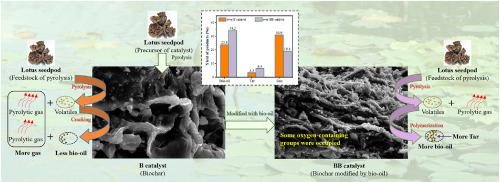Impregnation of bio-oil to homogenous biochar diminishes activity in volatiles-char interactions during pyrolysis of lotus seedpod
IF 5.8
2区 生物学
Q1 AGRICULTURAL ENGINEERING
引用次数: 0
Abstract
Volatiles-char interactions in pyrolysis of biomass have been well documented, and increase of abundance of oxygen-containing species on surface of biochar might enhance activity for reacting with volatiles. This was investigated herein by modification of bio-oil to the homogenous biochar from pyrolysis of lotus seedpod followed by subsequent thermal treatment at 600 °C to enhance presence of aliphatic organics on biochar. The aim was to increase activity of the modified biochar for interacting with volatiles. Contrary to expectations, the pure biochar that was not modified by bio-oil effectively catalyzed cracking/gasification of volatiles to gases. The results were that the pyrolysis of lotus seedpod with pure biochar formed more gases (40.1 % versus 24.3 %) and lower yields of bio-oil (27.3 % versus 40.1 %) at 600 °C, compared with that of biochar modified with bio-oil. The biochar modified with bio-oil, however, showed negligible activity for cracking, but did catalyze condensation reactions to form more tar (5.4 % versus 3.7 % from the control experiment). The impregnation of bio-oil to biochar with subsequent calcination at 600 °C did not increase abundance of oxygen-containing aliphatics but made modified biochar more carbon-rich and oxygen-poor from cracking of organics in bio-oil. Such a loss of oxygen-containing species “deactivated” biochar. Dynamic change of reactivity of nascent biochar with volatiles with progress of pyrolysis also took place from losing oxygen species on surface of biochar. This made biochar more aromatic, thermally stable, hydrophobic but produced more volatiles while less gases, along with deactivation of biochar.

生物油浸渍均质生物炭降低了莲荚热解过程中挥发物-炭相互作用的活性
生物质热解过程中挥发物与焦炭的相互作用已经得到了充分的研究,生物炭表面含氧物质丰度的增加可能会增强与挥发物的反应活性。本文通过将莲荚热解后的生物油改性为均质生物炭,然后在600°C下进行热处理,以提高生物炭上脂肪族有机物的存在来研究这一点。目的是提高改性生物炭与挥发物相互作用的活性。与预期相反,未经生物油改性的纯生物炭有效地催化了挥发物的裂解/气化成气体。结果表明,与生物油改性的生物炭相比,纯生物炭在600°C下热解莲子产生的气体更多(40.1%比24.3%),生物油的产率更低(27.3%比40.1%)。然而,用生物油修饰的生物炭的裂解活性可以忽略不计,但确实催化了缩合反应,形成了更多的焦油(5.4%比对照实验的3.7%)。生物油浸渍生物炭后,在600℃下煅烧,并没有增加含氧脂肪族的丰度,而是使改性后的生物炭因生物油中的有机物裂解而富碳贫氧。这种含氧物种的损失使生物炭“失活”。随着热解过程的进行,初生生物炭与挥发性物质的反应性也发生了动态变化,原因是生物炭表面的氧丢失。这使得生物炭更芳香,热稳定,疏水,但产生更多的挥发物,而更少的气体,以及生物炭的失活。
本文章由计算机程序翻译,如有差异,请以英文原文为准。
求助全文
约1分钟内获得全文
求助全文
来源期刊

Biomass & Bioenergy
工程技术-能源与燃料
CiteScore
11.50
自引率
3.30%
发文量
258
审稿时长
60 days
期刊介绍:
Biomass & Bioenergy is an international journal publishing original research papers and short communications, review articles and case studies on biological resources, chemical and biological processes, and biomass products for new renewable sources of energy and materials.
The scope of the journal extends to the environmental, management and economic aspects of biomass and bioenergy.
Key areas covered by the journal:
• Biomass: sources, energy crop production processes, genetic improvements, composition. Please note that research on these biomass subjects must be linked directly to bioenergy generation.
• Biological Residues: residues/rests from agricultural production, forestry and plantations (palm, sugar etc), processing industries, and municipal sources (MSW). Papers on the use of biomass residues through innovative processes/technological novelty and/or consideration of feedstock/system sustainability (or unsustainability) are welcomed. However waste treatment processes and pollution control or mitigation which are only tangentially related to bioenergy are not in the scope of the journal, as they are more suited to publications in the environmental arena. Papers that describe conventional waste streams (ie well described in existing literature) that do not empirically address ''new'' added value from the process are not suitable for submission to the journal.
• Bioenergy Processes: fermentations, thermochemical conversions, liquid and gaseous fuels, and petrochemical substitutes
• Bioenergy Utilization: direct combustion, gasification, electricity production, chemical processes, and by-product remediation
• Biomass and the Environment: carbon cycle, the net energy efficiency of bioenergy systems, assessment of sustainability, and biodiversity issues.
 求助内容:
求助内容: 应助结果提醒方式:
应助结果提醒方式:


